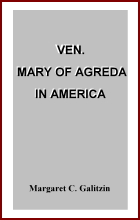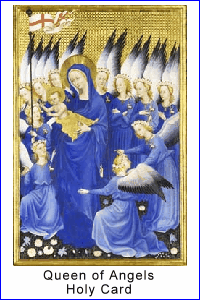Symbolism
 |
 |
 |
 |
 |
 |
 |
The Symbolism of the Stag
When I saw the beautiful Virgin and Angels on the holy card recently printed by TIA, I became curious about the stag brooch that each Angel wears. Why would a Choir of Angels be identified by a stag?
I began my search by looking for the meaning of the stag in medieval art, so rich in symbolism that whole books, called Bestiaries, were dedicated to describing what each animal represented in the plan of God.
Medieval symbolism
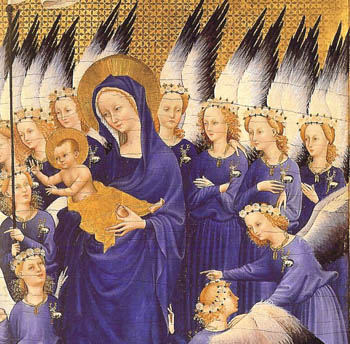
Each of the 11 angels wears a stag brooch
The stag is a symbol for Christ, Who tramples and destroys the Devil. Early bestiaries describe the stag as a relentless enemy of snakes. The stag was believed to pursue snakes into their holes or rock crevices, flushing them out by flooding the hole with the breath or water from its mouth, and devouring them.
Because the snake is a symbol of Satan, the stag's war against them made the stag a symbol of Christ and the Catholic in his battle against the evil one. The water used to flush out snakes became symbolic of Christ's wisdom and purity, the Gospel, and the water that flowed from His pierced Side on the Cross.
It was also believed that a stag that was ill or old would draw a snake out of hiding and swallow it. The stag then would drink large amounts of water to overcome the serpent’s poison, and thus be rejuvenated. So also, says the Bestiary, is the Christian saved, for ”sin’s trace is lost when in the baptismal font he is washed.” (Biedermann, 93)
When the stag is rejuvenated it sheds its horns after drinking from the spring, so those who drink from the Spring of the Living Waters are rejuvenated and shed their sins.
When stags must cross a river to find food, they swim in a line with one stag's head resting on the rear of the one in front of it. When the front stag tires, it moves to the end of the line to rest. As the stags crossing a river help each other, so should the Catholic crossing through the difficulties of the spiritual life help others who grow weak or tired.
In the Old Testament
King David makes the stag a symbol of the soul's longing for God: “As the hart pants after the fountains of water; so my soul pants after thee, O God.” (Ps 42:1)
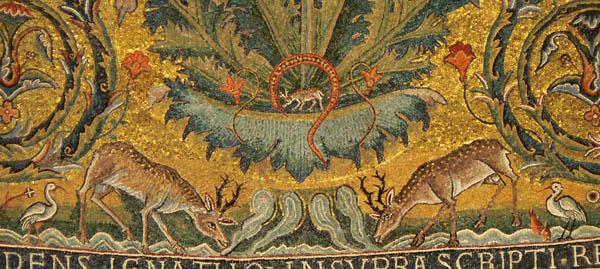
A mosaic over one of Rome's oldest basilicas
Because of this passage, in Christian art the stag and deer became associated with the soul’s desire for purification through Baptism and the Holy Eucharist.
For this reason it is often found on baptismal fonts, Communion rails and chalices. The mosaic over the 3rd century altar in Rome’s Basilica of St. Clement, for example, depicts stags drinking the water of life from the running stream.
In the Wilton Diptych
Clearly, the stag – which represents Christ – is a fitting symbol for the Choir of Angels. But it seemed that there was something more behind the stag brooches the Angels wear in the Wilton Diptych (1395-1399), a late medieval two-hinged panel, painted on both sides.
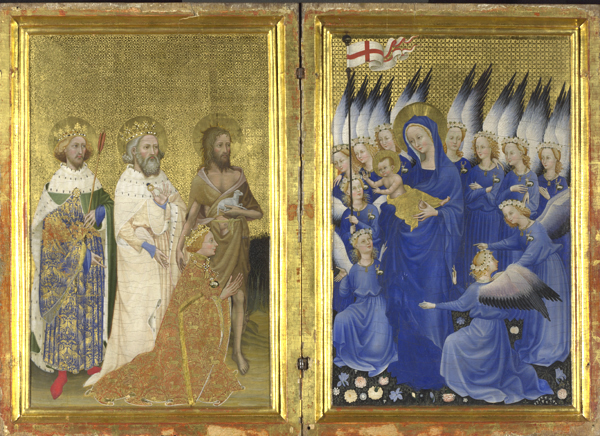
The inside panels of the Wilton Diptych
The diptych was commissioned by King Richard II of England who, on the opposite panel, is depicted kneeling before the Virgin and Child in what is known as a votive portrait.
King Richard II is presented to Our Lady and the Christ Child by his patron saints: St. John the Baptist with his symbol of the Lamb of God; Edward the Confessor with the ring he gave to a poor pilgrim who was really St. John the Evangelist, and Edmund the Martyr holding the arrow that killed him.
Now then, if we look closely at the young King’s rich outer robe of red vermillion at left, we find the fabric is embroidered with gold stags. A brooch with a white stag – the heraldic emblem of Richard II – also clasps the robe in the center.
The mystery of the Angels surrounding the Virgin is solved. All of the Angels in that group of 11 are wearing badges with Richard’s livery, the white stag, a sign of Heaven’s protection over his reign.

The white stag, emblem of King Richard II
But, why 11 Angels, an unusual number in medieval iconography since it had a negative connotation? Richard began his reign at age 11 in 1377, when he gave 11 gold coins called ‘angels’ to Our Lady of the Pew at Westminster Abbey.
The 11 angels tell us that Richard II gave his kingdom into the hands of the Holy Virgin from the very beginning of his reign, thus continuing a long and very beautiful tradition by which England was known as "Our Lady's Dowry" and was under her protection in a special way. In effect, the King is saying, "England is your dowry, O Holy Virgin, wherefore, O Mary, may you rule over her.”
Any Englishman of the time who sees this picture knows, therefore, that the King has entrusted both his kingship and the Kingdom of England to Our Lady and her Divine Son.
The symbolism is completed by the pennant with the red cross on a white background that is held by one Angel, which in medieval art is symbolic of the Resurrection. But here it has a meaning more relevant to England since it is also the Cross of St. George, the symbol of England, and on the top of the staff is an orb which is a tiny map of England. Thus, the Christ Child reaches to receive the pennant of England piously offered by the young King.
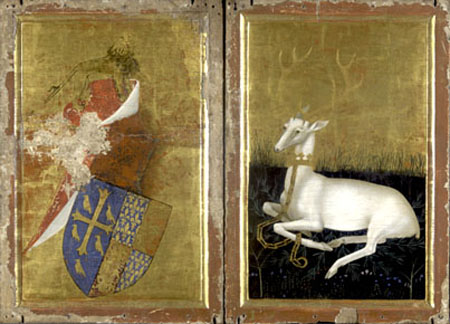
The cover of the Wilton Diptych
Should any reader doubt the significance of the white stag in these two panels, let him close the diptych and view the opposite sides. The cover reveals on one side a white stag, King Richard’s emblem, with a golden coronet around its throat sitting on a grassy meadow dotted with springs of rosemary under a golden sky. (The rosemary is the emblem of his wife Anne of Bohemia who died in 1394.)
On the other side is a coat of arms of King Edward the Confessor – adopted by Richard around 1395 shortly before the diptych was painted - under the arms of the Kings of England.

Posted November 5, 2011
I began my search by looking for the meaning of the stag in medieval art, so rich in symbolism that whole books, called Bestiaries, were dedicated to describing what each animal represented in the plan of God.
Medieval symbolism

Each of the 11 angels wears a stag brooch
Because the snake is a symbol of Satan, the stag's war against them made the stag a symbol of Christ and the Catholic in his battle against the evil one. The water used to flush out snakes became symbolic of Christ's wisdom and purity, the Gospel, and the water that flowed from His pierced Side on the Cross.
It was also believed that a stag that was ill or old would draw a snake out of hiding and swallow it. The stag then would drink large amounts of water to overcome the serpent’s poison, and thus be rejuvenated. So also, says the Bestiary, is the Christian saved, for ”sin’s trace is lost when in the baptismal font he is washed.” (Biedermann, 93)
When the stag is rejuvenated it sheds its horns after drinking from the spring, so those who drink from the Spring of the Living Waters are rejuvenated and shed their sins.
When stags must cross a river to find food, they swim in a line with one stag's head resting on the rear of the one in front of it. When the front stag tires, it moves to the end of the line to rest. As the stags crossing a river help each other, so should the Catholic crossing through the difficulties of the spiritual life help others who grow weak or tired.
In the Old Testament
King David makes the stag a symbol of the soul's longing for God: “As the hart pants after the fountains of water; so my soul pants after thee, O God.” (Ps 42:1)

A mosaic over one of Rome's oldest basilicas
For this reason it is often found on baptismal fonts, Communion rails and chalices. The mosaic over the 3rd century altar in Rome’s Basilica of St. Clement, for example, depicts stags drinking the water of life from the running stream.
In the Wilton Diptych
Clearly, the stag – which represents Christ – is a fitting symbol for the Choir of Angels. But it seemed that there was something more behind the stag brooches the Angels wear in the Wilton Diptych (1395-1399), a late medieval two-hinged panel, painted on both sides.

The inside panels of the Wilton Diptych
King Richard II is presented to Our Lady and the Christ Child by his patron saints: St. John the Baptist with his symbol of the Lamb of God; Edward the Confessor with the ring he gave to a poor pilgrim who was really St. John the Evangelist, and Edmund the Martyr holding the arrow that killed him.
Now then, if we look closely at the young King’s rich outer robe of red vermillion at left, we find the fabric is embroidered with gold stags. A brooch with a white stag – the heraldic emblem of Richard II – also clasps the robe in the center.
The mystery of the Angels surrounding the Virgin is solved. All of the Angels in that group of 11 are wearing badges with Richard’s livery, the white stag, a sign of Heaven’s protection over his reign.

The white stag, emblem of King Richard II
The 11 angels tell us that Richard II gave his kingdom into the hands of the Holy Virgin from the very beginning of his reign, thus continuing a long and very beautiful tradition by which England was known as "Our Lady's Dowry" and was under her protection in a special way. In effect, the King is saying, "England is your dowry, O Holy Virgin, wherefore, O Mary, may you rule over her.”
Any Englishman of the time who sees this picture knows, therefore, that the King has entrusted both his kingship and the Kingdom of England to Our Lady and her Divine Son.
The symbolism is completed by the pennant with the red cross on a white background that is held by one Angel, which in medieval art is symbolic of the Resurrection. But here it has a meaning more relevant to England since it is also the Cross of St. George, the symbol of England, and on the top of the staff is an orb which is a tiny map of England. Thus, the Christ Child reaches to receive the pennant of England piously offered by the young King.

The cover of the Wilton Diptych
On the other side is a coat of arms of King Edward the Confessor – adopted by Richard around 1395 shortly before the diptych was painted - under the arms of the Kings of England.

Posted November 5, 2011
______________________
______________________



